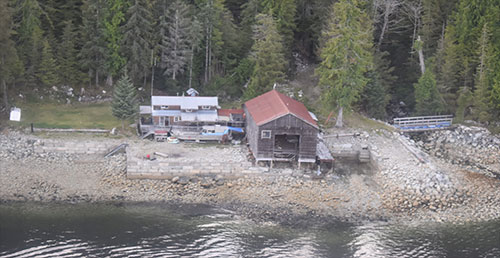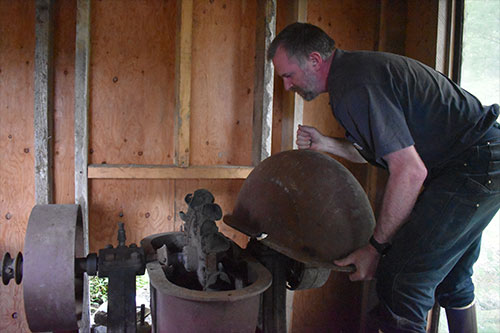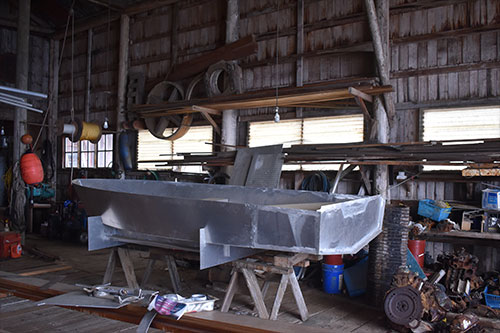A historic boat works struggles to hang onProperty dispute threatens 80-year old boat shopBy DAVE KIFFER September 30, 2019
“Larger vessels were typically built in larger shipyards along the coasts of the continent, however smaller vessels in the range of skiffs to seine boats 40' or more were often built locally,” historian and archeologist Ottar Mobley wrote in 2015. “A number of commercial boat works were established in Southeast Alaska during the early part of the century.”
Among the boat works that sprouted in the first half of the 20th Century was Israel Steven’s facility at the mouth of Wolf Creek on Prince of Wales Island near Hollis. Stevens was familiar with the area because his father had managed the nearby Flagstaff Mine. Stevens began residing on Forest Service land at the mouth of the creek in late 1939 under a special use permit. He built his boat works, originally called the Twelvemile Arm boat shop, in 1940. Later it would be called the Wolf Creek Boatworks. According to Mobley’s research the machinery was powered by water from Wolf Creek, which was transferred to the boat shop with a wooden flume that powered the belt drive equipment and a small Pelton wheel was fed from a four inch steel pipeline which drove a small generator. Eventually, a large 18 inch wooden piepelin and a 1902 S. Morgan Smith water turbine and generator were installed to provide both mechanical and electrical power. A cradle was built inside the open boatworks and eventually a marine rail and grid system was built along the north side of the building. Between 1946 and 1960 a sawmill was co-located with the boat works and trees in the surrounding area were felled to build the boats.
Mobley determined that between 1939 to 1951 Stevens made small skiffs which he sold. Additionally he also built larger boats at the property for himself. Stevens sold the boatworks to John Stacker in 1951. The boatshop changed hands several times between 1951 and 1994, when it was purchased by Alaska state ferry system engineer Sam Romey. Romey began a quarter century effort to (1) restore the boat works and (2) get some form more permanent claim on the land. “I was not looking for a place at that time in my life, especially this place.,” Romey said recently. “I was working on the Aurora and the chief engineer at that time owned the place and he was trying to sell it because the USFS would not allow him to use the land for a fishing lodge. He kept pestering me to buy it and he kept lowering the price. After looking at it several times and talking with my dad about it we decided to purchase it and restore the place.”
But Romey and his father did what the Forest Service asked in their effort to get the permit extended. “When we took ownership of the place it was pretty run down and the vegetation had grown up all over the house and shop and lots of woodwork on the decks floors and siding needed to be replaced. It was not something we took lightly, and the love of old equipment and the history of the place is really what got us. You have to add grease to the cups for the bearings then as its running tune the cups down a few turns to lube the bearings, the belts need to be dressed and kept tension just right and of course the turbine has to be monitored and regulated so the system does not overspeed.” “You learn to feel the vibrations and listen to the sounds of the equipment running to know what is running and what is not as well and what is wrong. It’s like a little symphony and you just haveto treat it like the beautiful equipment it is. We did meet the deadline and installed a grid which was popular with the boat owners in Hollis, Kassan and even one customer that would come all the way from Thorne bay to get their yearly 'shave and haircut'." The restoration has proved easier to resolve than the title issue. Romey has begun to produce aluminum skiffs at the site. But the title is clouded up in the convoluted Mental Health Lands Trust reconstitution process. As it now stands, the Trust wants Romey to vacant the site so a nearby logging operation can take place. Romey contends that the logging could take place and have no effect on the six-acre boat works site. Because Wolf Creek is an anadromous fish stream, state law requires a logging setback of up to 300 feet from the stream, so most of the area around the boat shop could not be logged anyway. Former Forest Service Archeologist John Autry determined that the site qualifies for National Historic Register status.
“The Wolf Creek boat works is likely to provide information important to the history of the local area, this significance is derived through the relative integrity of the structure, machinery and power system,” Autry wrote in the late 1980s. “A boat works of this type may have been commonplace during its time, but the integrity should be considered a rarity today. There has been no systematic or organized documentation of the ship/boat building industry in Southeast Alaska. The documentation of this significant historical theme is a critical element in preserving the regional and local maritime heritage.” Unfortunately, Romey says, when the site became part of the reconstituted Trust lands, efforts to preserve the historic boat shop reached a standstill. The Trust reconstitution process has been a controversial one in Southeast because lands was originally given by the State to the Trust to fund its services and then taken back by the State Legislature. A decades long court battle took place and eventually the State was ordered to make more land available to the Trust. The Trust then selected additional lands that were also controversial because of their locations near cities such as Ketchikan, Juneau and Petersburg. Another lengthy process took place (see “Debate over Deer Mountain logging began more than 20 years ago,” SITNEWS, Aug. 29. 2019). Eventually USFS land – a large portion of which was on Prince of Wales Island – was added to the exchange to get the Trust to trade away the more sensitive land around the Southeast cities. That exchange moved the Wolf Creek Boatworks property to the Trust and Romey says the Trust is now pushing him to “move” his operations elsewhere and leave the boat work buildings, something that Romey has no interest in doing. Romey recently met with Forest Service officials to discuss the situation and they said they favor cutting out the Wolf Creek land from the Trust land transfer or the continuation of the special use permit but that the ultimate decision is up to the Mental Health Lands Trust. Romey says the Trust still wants him to vacate the land. He says he is in touch with US Sentator Lisa Murkowski’s office to see if they can do anything to help. The 117-year old Francis water turbine powers the half-dozen belts that ring the rafters and cause the ancient band saw, planer, cutoff saw and sharpening stone to spin. When fired up, the belts and the saws still hum, sawdust risen into the rafters, and the entire boathouse vibrates. It is the sound of an industry that helped build Southeast Alaska. And may soon be consigned to history.
On the Web:
Contact Dave at dave@sitnews.us Dave Kiffer ©2019 Publication fee required. © Representations of fact and opinions in comments posted are solely those of the individual posters and do not represent the opinions of Sitnews.
|
|||||||







